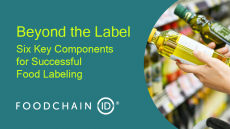Multiple Organics grew at home by connecting to farmers across globe, exec says

Multiple Organics spend $6 million on the new facility that will allow warehousing capacity for two and a half times the company's current product inventory level. It has been designed and constructed as a state of the art, secure, food storage and handling facility that also includes green design elements for efficient climate control and low energy usage.
Food safety
But one of the key advantages of the new facility is it will help Multiple Organics more fully incorporate the elements of its comprehensive food safety testing program, something that is a differentiator for the company, according to Jim Hoover, director of global sourcing for Multiple Organics and now a member of the company’s board of directors.
“There are a lot of other larger companies that do what we do,” Hoover told FoodNavigator-USA. “This will be our 11th year. We have been growing in a lot of different ways, and we are finally starting to get the exposure that we are looking for.”
So why buy from Multiple Organics, when there are a number of big players in the market, companies that handle bigger volumes?
“There were two big things that we were after that we not only felt personally responsible for but that we also felt gave us an opportunity in the industry,” Hoover said.
“One is our food safety program–MOST, which stands for Multiple Organics Safety and Testing–but also our giveback program where we are active in some of the regional communities where we source ingredients,” he said.
Out here in the fields
Under the MOST program, employees go to great lengths (and distances) to verify the quality and organic bona fides of the ingredients that Multiple Organics sells, Hoover said. These include chia, allergen‐free chocolate and other cocoa products, dried fruits, edible seeds, beans, lentils, nuts, peas, specialty grains like quinoa and sugar.
“We’re a pretty small company but we spend a tremendous amount of time and resources working with our supply partners globally. We spend a lot of time physically in the field, whether it’s South America, whether it ‘s in Asia, whether it’s in Turkey.
“We’re developing our relationships (with growers), but we are also looking at the products, seeing how they are growing. While we are there we are also spending time working with them in their processing facilities, making sure they are up to snuff on the food safety side and making sure they are producing things the way they have to be produced,” Hoover said.
The new facility will not include a laboratory, Hoover said. The company will continue to send test samples out to third party labs as it has in the past. While some companies see advantages in owning and controlling test facilities, Hoover said the Multiple Organics team likes to point to the potential higher integrity of a third party test result.
Giving back
As part of the company’s giveback program, Multiple Organics has funded a solar power project for Peruvian farmers who grow organic chia for the company. To date, the project has supplied 200 lights powered by solar batteries to farming families. The program has also helped build a school for tsunami victims in Sri Lanka, has helped fund construction of a medical center in Kenya and has helped Colombian women set up their own garment businesses.
The new facility will position the company to participate in what Hoover sees as a continued pattern of growth in the organic sector.
“I think right now we are going to continue to see some growth. I think it depends a variety of factors. I think that if we continue to see acceptance by the typical natural food buyer, if we continue to see more crossover from mainstream consumers, if we continue to see from the manufacturing community more research and development for more product offerings . . . if we continue to see all of those I think we will seem the same growth or even higher growth,” Hoover said.





















